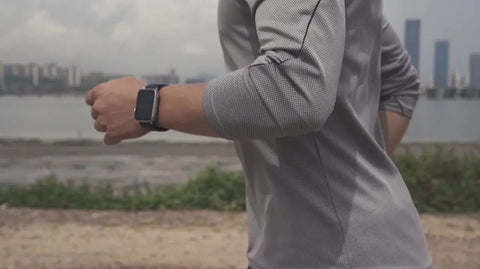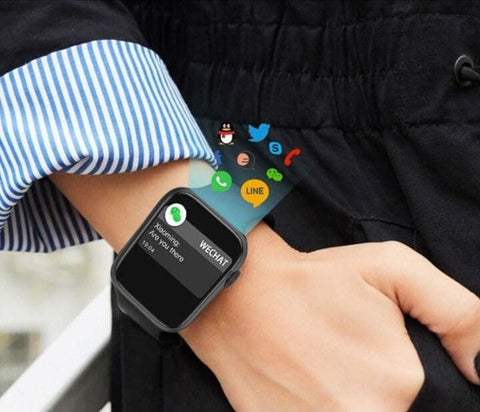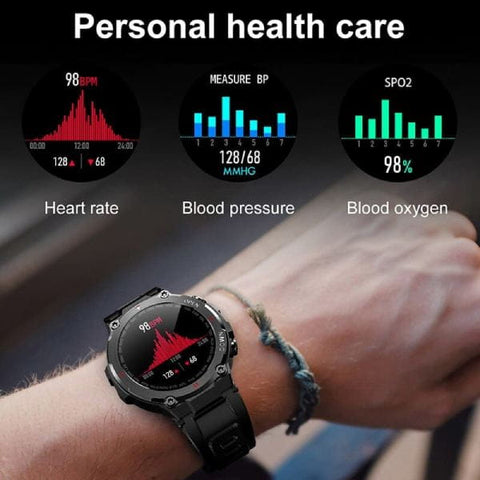
10 tips on how to get the most out of your smartwatch or fitness tracker
What the instruction manuals don't tell you
Got a new fitness tracker or smartwatch for Christmas. Awesome! Now what?
Whether you have the latest Apple Watch, Fitbit, Oura ring, or any other fitness tracker or smartwatch, it will come with instructions—online or in a physical booklet—to help you familiarize yourself with the device.
You'll need to download the companion app, pair your device with your phone, charge it, and learn how to use the basic features. Exactly how you do these things will vary from device to device, and we recommend that you follow the step-by-step instructions.
However, most instructions only get you started. But what comes next? Apart from the basic settings, there are many other things you need to know to get the most out of your new smartwatch so that it can make a positive difference in your life and work for you, not against you. You don't want it to become a waste of money or another gift that gets shoved in some drawer and forgotten.
Of course, every wearable is different, and so is every person who wears it. Our offerings are aimed at the broad audience of smartwatch users.
1. Correct fit
It's very easy to put on any smartwatch or fitness band and start using it. But it's important to keep in mind how it fits you. Does the strap buckle? Does the material annoy you? If it's not comfortable for you now, you won't want to wear it in the future.
You want a "just right" fit that isn't so tight that it leaves marks on your wrist, but is tight enough for the sensors to work properly. For example, most devices these days have a heart rate sensor built into the back. In order for this to accurately measure blood flow, it needs to be snug against your skin.
Play around with how tight you wear your new smartwatch or fitness tracker, and if necessary and possible with your device, change the band to one that fits better or is made of a more comfortable material.
2. Change the application dashboard
The main thing to remember when you get a new smartwatch is: make it work for you. We mean there are a lot of devices out there that can track and do all sorts of things. Some people may like this and want to learn everything there is to know about their sleep, fitness levels, stress levels and more. Others may simply want to count their steps and occasionally view heart rate data. Just because your device can do everything doesn't mean you have to track everything. This can cause you to get overwhelmed, focus on numbers that don't really matter to you, and cause you extra stress that you don't need.
It's a good place to start by determining what's important to you and what's not, and customize the stats you see on your app dashboard. It's not possible to do this for every smartwatch or fitness band. But some allow you to "edit" which stats are displayed when you open the app. For example, with the Fitbit app, you can customize your dashboard so you don't see anything about calories. This is really handy if you want to feel generally fitter and healthier, but don't want to focus on weight loss – which can be problematic for some people.
3. Customize the OSD menus
You often do a certain type of workout, but it's at the bottom of the workout list. Of course, we can just scroll down to select it. But it will only take a minute or two to move it to the top using the app, making things easier and more intuitive. If you have a device that has a screen and allows you to customize or make small adjustments to what you see on it, take some time to make sure it's exactly what you need - in the order you need it .
This may not seem like a big deal. Who cares if you have to scroll twice more to find the workout you need? But these little stumbling blocks can make using technology feel more like a chore than something useful and convenient, especially if they start to add up. So taking the time to change these settings will help in the long run.
4. Choose the right charging location
We've tried a lot of wearables over the years. Sometimes we had to take them off to charge them and immediately put them back on once the battery reached 100 percent. Others are left charging for days because we simply forget about them in the midst of all the other tasks we have to do. Where you charge your wearable really matters.
Under a desk, out of sight, out of mind? Not good. In the kitchen near the coffee machine so we see it every time we go to get another shot of caffeine? Perfect. This place will be different for everyone, but again, the goal is to make it easier to use your new fitness tracker on a daily basis. Because the initial excitement you feel is unlikely to last long.
5. Make using your smartwatch a good habit

Choosing the best place to charge your smartwatch or fitness tracker so you don't forget it is a good start. It's good to think about how to make wearing your device something natural and habitual.
That's why we recommend borrowing some suggestions from habit-building theory.
Stanford University sociologist and researcher BJ Fogg is a big believer in the power of prompts. In his book Tiny Habits , he explains that no behavior happens without prompting. Prompts can be physical, like this example, maybe you could put a note saying "fitness bracelet" next to your coffee machine or on the mirror? They can also be contextual. This is when you are prompted to do something because you associate it with something else - in the example above - we associate making coffee with putting on the bracelet.
Other prompts Fogg recommends are: sending a text message, writing on the bathroom mirror, setting an alarm with your voice assistant, and sticking a note on your fridge.
The good news is that this simple prompt for one simple behavior can have a positive effect on other behaviors. Fogg writes, "what started with one becomes an avalanche of productivity."
6. Connect to other applications and services
Most smart bracelets can do a lot, but they can't tell you everything you need to know about your health and fitness. For example, many can track your activity and heart rate levels. But not many have period tracking features that are as good as apps like Clue and Glow. What's more, some have nutritional tracking databases, but not many are as extensive as MyFitnessPal. This means you may want to sync the apps you already use and love with your new device and its app. Simply put, you'll want to get your apps talking to each other so you can get more out of each one—and learn more about yourself.
The way to do this is different for each smartwatch or bracelet, but most have a section in the settings called "apps" or "connections". There is usually a list of supported apps here and you can choose which ones you want to give permission to access your health and fitness data.
It's also a good way to revoke access to apps you don't want to access your health and fitness data. At this point, watch out for apps that try to seek permission to access data that they simply don't need. Always question whether the app really needs to know your step count or your location. If it's not obvious why, then don't allow it.
7. Find the notification settings that work for you

If you have a smartwatch or bracelet with a screen, chances are you're getting notifications from your phone sent to your wrist as well. Some devices can only notify you of text messages and calls. Others can send any notification from an app, including WhatsApp, email or other notifications sent to the screen.
The question is: is this a good idea or could it lead to unnecessary worries? The answer is: it all depends on you. Personally, we prefer that any notification that appears on our phone screen also appears on the smartwatch. We think this is useful because if we start using our phones for one thing, there's a good chance we'll get distracted by something else. So, using the phone takes a lot longer – and often the original reason for using it can be completely forgotten!
But just because it works for me doesn't mean it's right for you. We know that some people feel that sending all their notifications to their wrists is a burden and would like to keep that message-free space instead. The settings to turn them on, off or customize are in the app on your smart bracelet or watch. We recommend trying them out to see what settings are right for you.
8. Set your goals

If you have a fitness tracker, for a specific reason, use it optimally and set the goal in its settings. This could be the number of steps for the day or the distance traveled or the duration of a workout. If you want to improve your overall fitness, you might set a goal to exercise three times a week.
We love using fitness bands, even when we don't have a super specific goal in mind, but there's always going to be something we'd like to achieve—eight hours of sleep, 8,000 steps, or something. The key for us over the years has been to focus on just one thing at a time. Smartwatches can track many things, but it's more efficient to wear just one.
This is also the main premise of Greg McKeown's book Essentialism . The idea is that in order to achieve more, we must pursue fewer things and do them better. There's a lot more to McKeown's essentialist view of life, but there are a few key things to remember when it comes to fitness trackers: choose what to focus on (don't feel like you have to do everything), remove distractions towards achieving your goals and experience joy in the process.
That sounds good in theory, but what does it look like in practice? We suggest editing the app's home screen so that what you want to focus on is there and everything else isn't. Similarly, customize the app and the watch screen.
9. Take It Down (Yes, Really)
Many of the best fitness trackers these days are designed to be worn 24/7 – you just need to take them off every few days or a week to charge them for a few hours. That's why this tip might seem a little strange. But it's important to go out without your tracker every once in a while.
This will reduce the chances of you becoming too dependent on your fitness tracker. But haven't we already discussed how to create habits with it? Absolutely. But there has to be a balance. The majority of people have no problem focusing too much on smart devices and the data they collect, but there are cases of people who obsess over sleep data, as well as others who have eating disorders triggered or exacerbated by calorie data and activity that are so readily available.
10. Ask yourself: what is your why?
When we spoke with Dr. Carolyn Plateau, she told us that people are less likely to have problematic relationships with devices when they are used to enhance overall well-being and achieve a positive goal, rather than one that can be and negative, such as weight loss. There's nothing wrong with wanting to lose weight and feel better, but often people obsess and obsess over it, leading to stress and eating disorders. So it is worth considering "why" you want to achieve the set goal.
With all the focus here on goal setting and habit building, it's also worth mentioning that fitness trackers can be used as a start to build awareness. What I mean is that maybe you don't know what your goal should be for sleep time or step count. Where would you start?
Our advice is to use the tracker for a month to see your current state, what is possible and what you would like to achieve in the future. So much talk about constant improvement and upgrade. Maybe you just want to have a better view of your own body and well-being and wish the parameters to stay as they are. There is no right or wrong way to use health and fitness technology.
